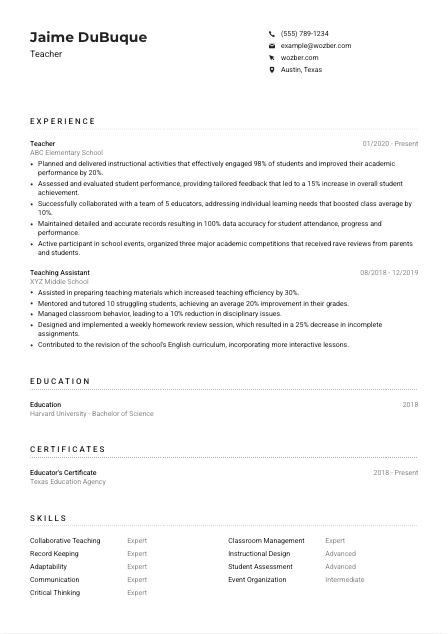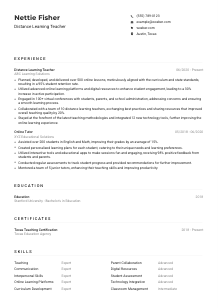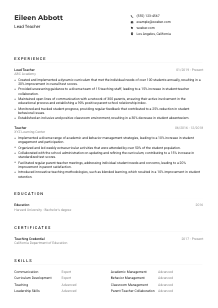Teacher Resume Example
Molding minds, but your resume doesn't make the grade? Delve into this Teacher resume example, shaped with Wozber free resume builder. Learn how to articulate your educational expertise and classroom charisma to match job requirements, making your career journey as enriching as a light bulb moment!

How to write a Teacher resume?
Greetings, inspiring Educator! Your journey to making a meaningful impact in students' lives starts with a stellar resume that speaks volumes to hiring managers. In the education sector, showcasing not just your qualifications but your passion and dedication is crucial.
This guide, powered by the prowess of Wozber free resume builder, is your compass to creating a resume that not only aligns with the Teacher job description you're eyeing but also passes through Applicant Tracking Systems (ATS) with flying colors. Let's mold your resume into a testament to your educational excellence and heartfelt commitment to teaching.
Personal Details
Your Personal Details section is like the classroom door—your chance to make a welcoming first impression.
1. Name as Your Headline
Think of your name as the title of your educational narrative. Make it bold and clear, like the headline of a lesson plan, ensuring it captures attention.
2. Job Title Alignment
"Teacher"—such a simple word, yet it encompasses a world of passion, dedication, and skill. Position this title prominently just below your name to mirror the job you're applying for, creating an immediate relevance to the reader.
3. Essential Contact Info
Detail your contact channels like the essential elements of a lesson plan—phone number and email are a must. A professional email format is akin to classroom etiquette; it communicates respect and professionalism.
4. Localize Your Application
Matching the job's geographical requirements is like adapting your teaching methods for your classroom. Explicitly mentioning "Austin, Texas" proves there's no relocation delay in launching your mission to educate.
5. Professional Profile
Adding a LinkedIn profile is akin to providing a broader curriculum vitae of your professional journey. Make sure it's up-to-date and reflects the dedication and achievements that you've outlined in your resume.
Takeaway
Your Personal Details section sets the tone for the resume. It's more than just information; it's the prelude to your professional teaching narrative. Precision here ensures the hiring manager knows exactly who is entering their educational realm.





Experience
The Experience section is your portfolio of teaching achievements. Here, you'll showcase your commitment to shaping minds and hearts.
- Planned and delivered instructional activities that effectively engaged 98% of students and improved their academic performance by 20%.
- Assessed and evaluated student performance, providing tailored feedback that led to a 15% increase in overall student achievement.
- Successfully collaborated with a team of 5 educators, addressing individual learning needs that boosted class average by 10%.
- Maintained detailed and accurate records resulting in 100% data accuracy for student attendance, progress and performance.
- Active participant in school events, organized three major academic competitions that received rave reviews from parents and students.
- Assisted in preparing teaching materials which increased teaching efficiency by 30%.
- Mentored and tutored 10 struggling students, achieving an average 20% improvement in their grades.
- Managed classroom behavior, leading to a 10% reduction in disciplinary issues.
- Designed and implemented a weekly homework review session, which resulted in a 25% decrease in incomplete assignments.
- Contributed to the revision of the school's English curriculum, incorporating more interactive lessons.
1. Dissect the Job Description
Dive deep into the job description, just like a well-prepared lesson plan, and highlight experiences that match the employer's needs. This is your blueprint for relevance.
2. Organize Your Teaching Timeline
Structure your teaching legacy chronologically, emphasizing roles and schools. This timeline illustrates your journey and growth in the education sector, demonstrating your evolving expertise.
3. Detail Your Impact
For every position you've held, articulate how you've made a difference. Did you enhance student engagement, or maybe you spearheaded a new teaching initiative? Mirror the job description, such as "planned and delivered instructional activities that engage students," demonstrating your direct alignment with their needs.
4. Numbers Tell Stories
Quantifying your accomplishments makes your success tangible. Whether it's improving academic performance by 20% or mentoring a specific number of students, numbers provide a concrete measure of your impact.
5. Relevance is Key
Focus on experiences that resonate with the teaching position. Extracurricular contributions, like organizing school events, highlight your dedication to the school community and match responsibilities like participating in school events and parent-teacher conferences.
Takeaway
Your experience section narrates your educational journey, underscoring your dedication, impact, and growth. Tailoring this section to the job's requirements shows recruiters you're not just a fit; you're the perfect candidate ready to bring your expertise and passion to their school.
Education
In the realm of education, your academic background is not just a credential; it's the bedrock of your teaching philosophy.
1. Match the Degree Requirement
Align your educational qualifications with the job's requirements. For instance, a "Bachelor of Science in Education" directly reflects the job's stipulation for a Bachelor's degree in Education or a relevant field.
2. Structure with Clarity
Present your educational achievements in a clear, straightforward format. This section is like the outline of a syllabus, providing a snapshot of your academic journey.
3. Degree Specifics
If your degree is a perfect match for the job specifications, like our example of a Bachelor of Science in Education, highlight it. This assures hiring managers of your focused training for the role.
4. Relevant Education Extras
Consider including significant academic projects, honors, or related extracurriculars that showcase skills relevant to teaching. These details add depth to your educational profile, similar to how a well-rounded lesson plan enhances learning.
5. Other Achievements
If there are additional educational milestones that underscore your dedication to teaching or continuing professional development, such as specialized workshops or seminars, don't hesitate to include them. They show your commitment to staying at the forefront of educational methods.
Takeaway
Your education section is more than a list of schools and degrees; it's a reflection of your preparedness and foundation for the teaching role. Highlighting the right aspects of your education assures schools that you have not only the right qualifications but also a dedication to growth and learning.
Certificates
In teaching, certifications are not just accolades; they're your passport to credibility and professional recognition.
1. Identify Essential Certifications
Focus on certifications directly related to the job, such as a state teaching certification, which is a key requirement. This aligns with the job description's need for a "Valid state teaching certification or license."
2. Prioritize Pertinence
Listing the most relevant certifications first places a spotlight on your qualifications. Ensure the information is succinct and directly aligned with the job's demands.
3. Dates Matter
Including the validity dates of your certifications, especially when they're a requisite like the "Educator's Certificate" from the Texas Education Agency, provides recruiters with necessary compliance information at a glance.
4. Continuous Learning
The education field is ever-evolving, and staying updated with current certifications demonstrates your dedication to professional growth. This commitment is crucial in a profession dedicated to lifelong learning.
Takeaway
Your certifications are a testament to your commitment to the teaching profession and ongoing professional development. They signal to hiring managers that you're not only qualified but also actively engaged in honing your craft.
Skills
Your skills section is the crystallization of your teaching abilities and pedagogical strategies.
1. Decipher the Job's Skillset
Start by identifying both the explicitly stated and the underlying skills required by the job. Skills like "strong proficiency in written and spoken communication" and "ability to adapt teaching methods" are directly mentioned and must be included.
2. Prioritize Alignment
Focus on listing skills that reflect the job description's needs, such as "Adaptability," "Communication," and "Critical Thinking." This ensures your resume speaks directly to what the hiring managers are looking for.
3. Organization and Neatness
Organizing your skills into a neat list not only makes for easier reading but also allows recruiters to quickly see how your abilities align with the job's requirements. Think of this as creating an easy-to-follow lesson plan, but for your professional competencies.
Takeaway
Approach your skills section as a carefully curated exhibition of your teaching toolkit. By aligning your skills with the job's requirements, you communicate to hiring managers that you have exactly what it takes to excel in the role. Remember, your skills are a reflection of your teaching style and effectiveness.
Languages
In our increasingly interconnected world, language skills can be a significant advantage, reflecting your ability to engage with diverse learning communities.
1. Match Job Language Requirements
"Must possess good command over English language" is a clear call from the job description. Showcase your proficiency in English, emphasizing your mastery in communication—a pillar of effective teaching.
2. Showcase Additional Languages
If you're fluent in languages beyond the required English, such as Spanish, list them to illustrate your versatility and readiness to connect with a broader range of students and parents.
3. Honesty in Proficiency
Be transparent about your language skills. Use clear descriptors for your proficiency levels, ensuring expectations are set accurately. This honesty reflects integrity, an invaluable trait in education.
4. Understand Role's Language Scope
Considering the teaching role's scope for interaction with a multicultural student body can highlight the additional value of your language skills. They're not just a communication tool; they're a bridge to cultural understanding.
5. The Value of Languages
Your linguistic skills broaden your teaching approach, enabling you to reach and resonate with more students. Viewing languages as assets to your teaching identity underscores the diversity and inclusivity you bring to the classroom.
Takeaway
Your command of languages is more than just a skill; it's an extension of your teaching philosophy, emphasizing inclusivity, communication, and understanding. It demonstrates your readiness to engage with an ever-diverse student population, making you an invaluable asset to any educational institution.
Summary
Your summary is the thesis statement of your professional narrative, setting the stage for the detailed account of your teaching journey that follows.
1. Core of the Job
Begin with an insightful look at the job description, identifying the essence of what the school seeks in a Teacher. Use this understanding as the foundation for your summary.
2. Introduce Your Story
Open with a clear, captivating statement about your professional identity as a Teacher, highlighting years of experience and your overarching approach or philosophy towards education.
3. Highlight Relevant Accomplishments
Weave in key accomplishments and skills that directly address the job's requirements, such as your ability to "adapt teaching methods to cater to diverse learning styles," showcasing how you meet and exceed the expectations.
4. Brevity and Impact
Strive for a summary that's both concise and powerful. Think of it as your opportunity to impart a lasting lesson in a short time, leaving the reader eager to learn more about your professional journey.
Takeaway
Your summary is the prelude to your professional story, enticing hiring managers to delve deeper into your resume. By crafting a narrative that's both reflective of the job requirements and demonstrative of your unique contributions to the field of education, you set the stage for a successful application.
Embarking On Your Educator Path
Congratulations on crafting a resume that reflects your passion, dedication, and readiness to make a difference in the world of education. As you finalize your resume with Wozber, harnessing its ATS-friendly resume template, ATS-compliant resume formatting, and precision-targeted content via the ATS resume scanner, remember that your resume is more than a document—it's a prologue to the impact you'll have in your teaching career. With your story finely tuned and your expertise clearly presented, you're ready to begin your journey in shaping the future.
Capture the essence of your educational mission, and let's illuminate the path to your next great teaching adventure.

- Bachelor's degree in Education or relevant field.
- Valid state teaching certification or license.
- Minimum of 2 years teaching experience in specified grade level or subject.
- Strong proficiency in both written and spoken communication.
- Ability to adapt teaching methods to different learning styles and needs.
- Must possess good command over English language.
- Must be located in Austin, Texas.
- Plan and deliver instructional activities that engage students and facilitate their learning.
- Assess and evaluate student performance, providing constructive feedback and support.
- Collaborate with colleagues to address individual and collective educational needs.
- Maintain accurate records of student attendance, progress, and performance.
- Participate in school events, professional development, and parent-teacher conferences as required.















